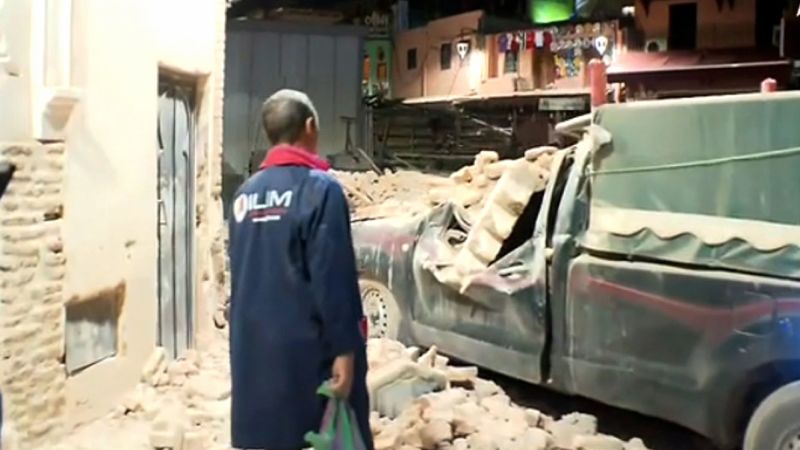CNN — More than 1,000 people have been killed after the deadliest earthquake in decades struck central Morocco, with rescuers digging through rubble in remote mountainous areas to find victims. The 6.8-magnitude earthquake shook Morocco’s High Atlas mountain range shortly after 11 p.m. local time on Friday at the relatively shallow depth of 18.5 kilometers (11.4 miles), the United States Geological Survey (USGS) said, with the epicenter located about 72 kilometers (44.7 miles) southwest of Marrakech, a city of some 840,000 people and a popular tourist destination.
At least 1,037 people were killed with more than 700 others in a critical condition, Morocco’s state TV Al Aoula said, citing the interior ministry. Eyewitnesses described scenes of destruction in the Atlas Mountains foothills following the earthquake. Fatima, 50, told CNN her house in the mountain village of Asni – near the earthquake’s epicenter – had been destroyed. “I barely got the chance to grab the kids and run out before I saw my house collapsing in front of my eyes. The neighbor’s house has also collapsed and there are two dead people under the rubble,” she said. Mohammed, 50, from the nearby town of Ouirgane, lost four family members in the quake. “I managed to get out safely with my two children but lost the rest. My house is gone,” he said. Rescue operations there are ongoing. “We are out in the streets with authorities as they try to pull the dead from the rubble. Many many people were transported to hospital in front of me. We are hoping for miracles from the rubble,” he said.
Not since 2004 has the country seen a comparable disaster, when a 6.3-magnitude earthquake struck the port city of Al Hoceima, claiming around 630 lives. Morocco’s worst earthquake of modern times was in 1960 near the western city of Agadir which killed at least 12,000 people. Many Moroccans spent Friday night on the streets fearful of aftershocks. Health authorities also called on people to donate blood to help victims.
In pictures: Powerful earthquake kills hundreds in Morocco
Most deaths occurred in mountain areas close to the epicenter that were hard to reach, authorities said, and rescue teams were having difficulty accessing the worst affected areas after roads were damaged, Al Aoula reported. The Royal Moroccan Armed Forces warned residents to pay close attention to follow-up tremors. “We remind you of the need to exercise caution and take safety measures due to the risk of aftershocks,” the military wrote on X, formerly known as Twitter.
The USGS said Friday night’s quake was unusually strong for that part of Morocco. “Earthquakes of this size in the region are uncommon, but not unexpected. Since 1900, there have been no earthquakes M6 (magnitude 6) and larger within 500 km of this earthquake, and only 9 M5 (magnitude 5) and larger earthquakes,” USGS said. The US body predicted that “significant damage is likely and the disaster is potentially widespread,” noting that many people in the area reside in structures that are “highly vulnerable to earthquake shaking.”
Al Aoula on Saturday broadcast video of multiple collapsed buildings near the quake’s epicenter and reported that thousands of people had fled their homes after the country’s National Institute of Geophysics warned of aftershocks. In the old city of Marrakech, a UNESCO World Heritage site, some residents were injured as buildings and city walls were damaged and partially collapsed, according to CNN researcher Benjamin Brown who is on the ground.
Brown, who was at the rooftop of his hotel when the ground started shaking, said it took a few seconds for everyone to realize what was going on. People initially remained calm as they made their way out of the narrow alleyways to find a safe place outdoors, many in their pajamas, according to Brown. “It kicked in a couple of minutes later, screaming began… when the extent of the injuries became apparent, that’s really when the panic kicked in,” he said. “I saw many people brought out of their homes in stretchers or wrapped in carpets…some of them with what appeared to be quite serious head injuries with lots of blood.” At least one ambulance had to turn away an injured woman because it was already full with injured people, Brown said.
Some parts of the historic red walls that surround Marrakesh’s old city center – which were first laid out in the early 12th century – also crumbled, he added. Videos and photos show open spaces in the city, including squares and traffic roundabouts, filled with people, some setting up makeshift beds to stay the night. Some houses in the city have collapsed and people were moving debris by hand while they waited for heavy equipment, local resident Id Waaziz Hassan told Reuters news agency.
“The chandelier fell from the ceiling and I ran out. I’m still in the road with my children and we’re scared,” Houda Hafsi, another Marrakech resident, told Reuters. A former imperial city with a history that dates back nearly 1,000 years, Marrakech is tightly packed with medieval-era palaces, mosques, gardens and bustling markets. Its historic quarters are surrounded by red earth walls and filled with buildings constructed in red sandstone, which gave the city its nickname the “red city.” Marrakech drew nearly three million tourists in 2019, before the Covid pandemic. In addition to its rich culture and history, Marrakech is also Morocco’s fourth largest city and a major economic center. Shaking was also felt in the capital Rabat, some 350 km (217 miles) north of the High Atlas mountains, Reuters said, citing eyewitnesses.

